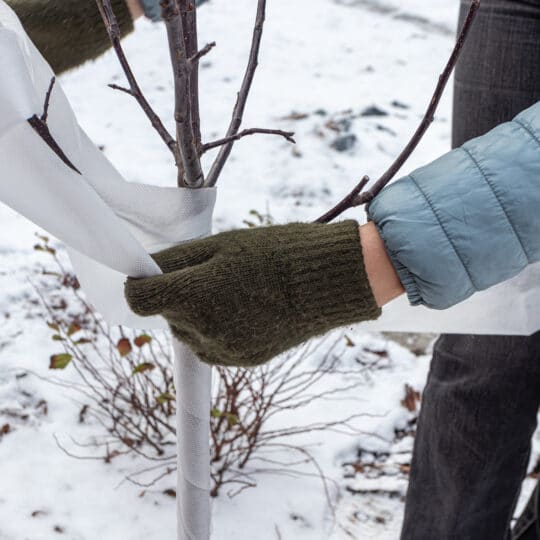Tree Wrapping
What it is & Why it’s Needed
Posted
January 14, 2021

Do you wrap your tree in the winter? Do you know what wrapping is? No, not that kind of wrapping; the holidays are over. Tree wrapping is done to help protect the vulnerable bark of certain trees from harsh conditions. There’s a right and wrong way to wrap, so be sure you familiarize yourself with how to do it properly.
What is Tree Wrapping
Those who have young or thin-barked trees may need to take extra precautions this winter. These vulnerable trunks could benefit from extra protection. One easy, affordable, and effective solution is to use tree wrap.
Tree wraps come in a variety of materials:
Polypropylene fabric. Its low cost, snug stretchiness, porous breathability, and water resistance make this the most popular type. It also naturally breaks down, so it won’t outstay its welcome.
Paper. Layers of uncolored, biodegradable kraft fabric/crepe paper that has a water-resistant wax layer. Has some stretch and breathability, but it tends to break down quicker than other materials, meaning more maintenance.
Burlap. Used for trees (like evergreens) that require more air circulation and less heat regulation. It’s an affordable option that’s also readily available. Breathable burlap can be purchased in a precut roll, sacks, or cut strips from sheets of burlap fabric.
The best type of wrap for your tree depends on the type of tree and the reason you’re wrapping it. No matter which type you choose, here’s how to wrap:
- Start wrapping upward from the base of the tree.
- Stop when you reach the lowest set of branches.
- At the top, cut the wrap and secure the end with a strip of tape.
- Make sure the fit is snug, but not too tight.
- Don’t secure the wrap with any kind of tie that could constrict the tree.
Why You Should Wrap
If your tree is more susceptible to damage, it’s best to help prevent it rather than fixing it later. Here are some reasons for wrapping:
- Extreme temperature fluctuations. The morning and evening could be a lot colder than the sunny afternoon.
- When the sun reflects off the snow it could cause burns or sunscald
- Hungry animals are looking for any available food and shelter.
Help prevent any of these issues from happening by adding an extra layer of protection around your tree. If your tree does become damaged, it could not only die, but it’s also more attractive to lawn pests.
When to Wrap Things Up
While some people choose to leave tree wrap on their trees year-round for added protection, most experts believe trees should only be wrapped during winter. If left in place, the wraps could produce excessive moisture retention and cause the bark to rot.
To play it safe, apply the tree wrap in the late fall and remove it in early spring. If you still need to protect it from animals other times of the year, consider a tree guard or fence.
Once your tree is protected, you can be confident that it will live to see another season. For any questions on tree wrapping, contact Cardinal Lawns.

Download Your FREE Summer Plant Care Guide
Help your plants make it through a hot & dry summer looking like a million bucks with our summer plant watering and maintenance guide!